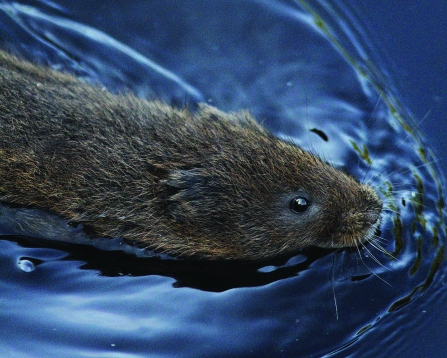A new analysis of data collected over ten years by a network of experts led by The Wildlife Trusts has revealed that water vole distribution has declined dramatically. There has been a 30% decline in the places where these river mammals once lived across England and Wales during this time.*
While the new analysis reveals a slight increase in distribution in recent years – thanks to some successful conservation efforts by The Wildlife Trusts to include Yorkshire Wildlife Trust on a regional level – the full data covering the whole ten years paints a bleak picture.
Water voles are a much-loved British mammal which used to be regularly seen and heard along every ditch, stream and river in the UK. A creature which burrows in banks and feeds on reeds and grass, the water vole was a lead character – known as ‘Ratty’ – in Kenneth Grahame’s children’s classic Wind in the Willows.
Huge conservation efforts have been made to ensure a future for this charismatic mammal: The Wildlife Trusts and others continue to carry out river restoration work and reintroductions of this species across the UK. At a local level, these projects appear to have been highly successful; however, these successes are not big enough to reverse the national distribution trends.
Conservation in action – Yorkshire
Yorkshire Wildlife Trust has been committed to targeted conservation work for water voles for the last 15 years, with dedicated projects and wider wetland landscape and river catchment restoration work aimed at reversing the decline of Britain’s largest species of vole.
In East Yorkshire this approach can be seen in action, with Yorkshire Wildlife Trust working to create a new mosaic of wetlands, including wet grassland, fen, ponds and flowing water at the Skerne Wetlands nature reserve near Driffield. The site sits in the heart of the River Hull headwaters chalk streams where a wider restoration plan for the whole area is being delivered.
Jon Traill, Living Landscapes Manager for Yorkshire Wildlife Trust, is leading the works at Skerne Wetlands. He says:
“Water voles have responded well to our efforts, with surveys carried out on the Skerne site last year showing a thriving population. Such work is vital to the success of enabling them to move out into the wider countryside.”
Jon adds: “The key to reversing this decline is re-connecting fragmented wetland habitats and restoring existing wetlands, rivers, ponds and ditches. We not only work on our own nature reserves, but also in partnership with other landowners, land managers and key government agencies and non-governmental organisations (NGOs), aiming to provide a well-managed, connected habitat network for water voles and other wildlife.”
Habitat loss, water pollution and massive building development have led to declines in the voles since the 1960s; exacerbated by predation by North American mink. The water vole is the UK’s most rapidly declining mammal and has been lost from 94% of places where they were once prevalent.* The latest data revealing a ten year decline of 30% shows an ever-worsening situation: their range is continuing to contract.
Ellie Brodie, Senior Policy Manager for The Wildlife Trusts, says:
“Water voles are an essential part of our wild and watery places and it’s terribly sad that we’re continuing to witness huge declines of this lovely mammal. The Wildlife Trusts and others are working hard to help bring them back again and care for the places that they need to survive – but much more is needed if we’re going to stop this charming creature disappearing altogether.”
The Wildlife Trusts are calling for:
- Government to provide better funding for water vole conservation projects and to initiate landscape-scale restoration schemes
- Government and Local Authorities to enable the creation of Nature Recovery Networks, as set out in the Government’s 25 Year Plan for the Environment. Nature Recovery Networks should protect, connect and create areas of natural habitat to help wildlife move through the landscape, benefitting not just water voles but a range of other wildlife.
- Landowners to manage river bank habitat positively to help water voles, e.g. providing generous buffer strips to provide shelter and feeding, opening up sections of the bank to the sun to prevent overshading, and creating soft edges to river banks for water voles to create burrows in
- People to volunteer as water vole surveyors with their local Wildlife Trust and/or donate to charities to help support water vole recovery work.
The Wildlife Trusts work across the UK restoring habitats to help water voles and other river wildlife as well as reintroduce them back to areas where they are not at risk from mink.
Notes:
*Ten year period: January 1st 2006 to 31st December 2015
*94% figure is from The Water Vole in Britain 1996-1998, R Strachan, The Vincent Wildlife Trust, London, 1998.

